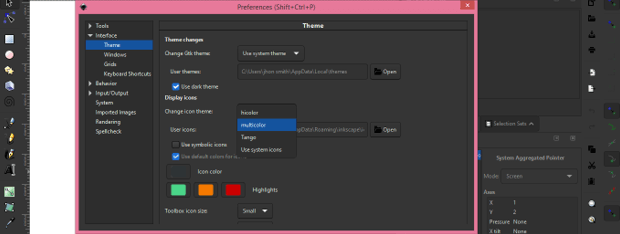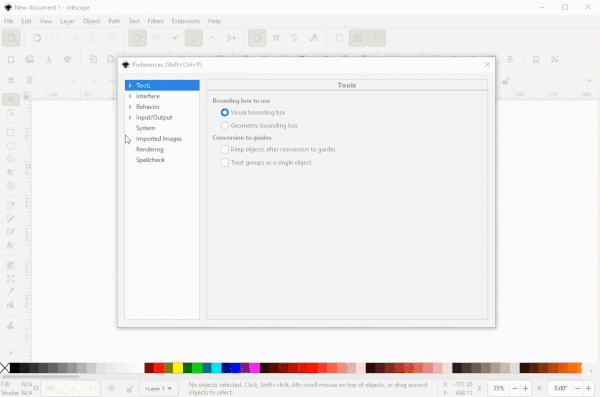


Thankfully, however, Inkscape has improved by leaps and bounds over the years.
#Inkscape dark theme install#
In older versions of this tutorial we had to download package files and install them manually as Inkscape didn’t yet have a dark theme at the time. Simply close out of the window once you are satisfied with the changes. The menu should look something like this: Click to enlarge.Īll you have to do is check the box that says “ Use dark theme” and the dark theme will be applied to the entire application immediately. In the Inkscape Preferences menu, expand the Interface option from the list on the left-hand side of the menu and select Theming. Or the keyboard shortcut: Command + Shift + P
#Inkscape dark theme mac#
Mac users can access it by navigating to: Or you can use the keyboard shortcut: Control + Shift + P
#Inkscape dark theme windows#
To access Inkscape Preferences, Windows and Linux users can navigate to: This is a menu that allows you to change many of the software’s settings at a granular level. The most certain way to apply a dark theme in Inkscape is via the Inkscape Preferences menu. Option 2: Use The Inkscape Preferences Menu If you do not get a Welcome menu that populates when launching Inkscape then proceed to the next option. Leaving it disabled will keep the standard light theme. Enabling this will launch Inkscape with a dark theme. This file has been truncated.Simply enable the switch labeled “ Dark” towards the bottom-right of the menu, under the Quick Setup tab.

I left the snakes’ eyes as solid white circles rather than knocking them out, because that felt more in keeping with the spirit of the logo-usage guidelines.) ferdnyc/python-logos/blob/main/python-powered-transparent.svg (Here, have that SVG, complete with background transparency enabled. #ForSomeReason! Despite all of the visible text being rendered as paths (and not typeset with Verdana anyway).ĭropping out the invisible layers, the proprietary Adobe crap, and all of the other cruft, I exported an Optimized SVG from Inkscape that brought it down from 176K to 13K, despite there being zero visible changes. There’s even an embedded copy of the entire Verdana webfont in an internal CSS stylesheet. Including at least two separate copies of what appears to be a spot-color chart one sits awkwardly on top of the graphic (partially obscuring it), the other is completely outside of the page area. The color issue aside, can we get some clean SVG files for these logos? That Python Powered logo SVG I linked to? That’s a 176K file, and despite the metadata claiming it was saved from Inkscape, it’s absolutely lousy with proprietary Adobe Illustrator vendor cruft! Not to mention, there are entire layers of invisible crap just dumped into it. The PSF is more than welcome to whatever I end up submitting to HP once it’s done, if you’d like. Everything else is left to the discretion of the downstream designer, which kind of invites horror-show situations like the HP use. Right now, the only official options are the 3-color renderings against a solid white background. Adding a white outline to the official logos so that they’re compatible with a wider range of background colors.Including dark-background versions as alternatives (where the “python” gray has been swapped to a light color), or.

Since dark-mode UIs are currently in fashion again, the PSF might consider expanding the set of official ready-made logo options made available. Two things I thought I’d mention here, though: so, a transparent version with an aesthetic, white outline (one of the explicitly never-needs-approval options for using Python logos, per the FAQ) is probably the way to go. I can also easily swap the the “Python” word color from gray to white, although then it’s a dark-theme- only logo which I’d rather avoid. While I can easily drop out the white background to make it transparent, that won’t solve the problem that the gray “Python” will look horrible over the “Adwaita dark” theme’s default window color. I’ve already downloaded the Python Powered logo SVG. (Ideally, in the original SVG format, since they’re using PyQt5 for the GUI and Qt has excellent support for SVG icons there’s no real reason to ever use bitmaps in a Qt interface unless for some wrong-headed reason you actually want to.) I figured I’ll just whip something up and hand it off to HP in the hopes I can convince them to replace that abomination with something that doesn’t suck. I’ve been to the logos & trademarks section of the website, and I’ve read the FAQ, so I know that both outlined and color-altered variations of the logo(s) are acceptable without approval. It seems clear they did the transparency themselves, for all of those logos, and they did it from white-background files without any regard for the possibility of them being placed on dark backgrounds.


 0 kommentar(er)
0 kommentar(er)
